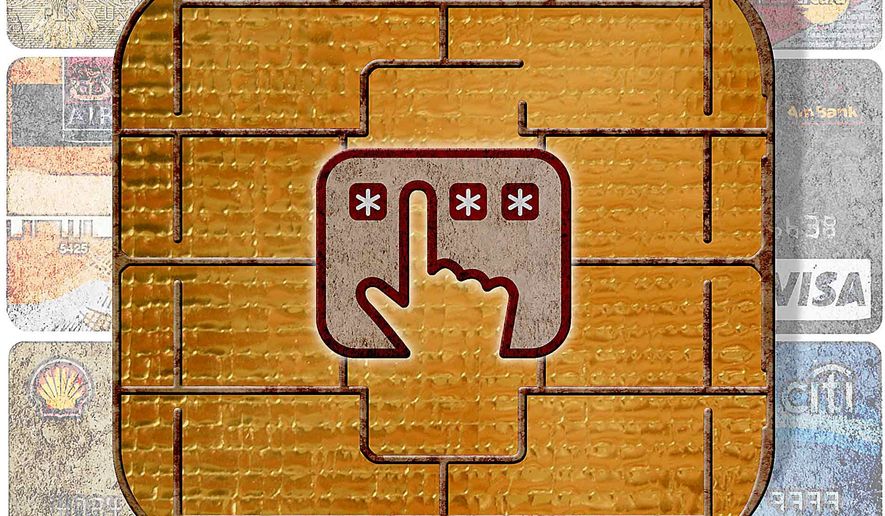OPINION:
Protecting Americans from online threats is clearly taking a rightful place at the top of Congress’ priority list, evident in the celebration of “Cyber Week” through Friday and the pending introduction of long-anticipated cybersecurity legislation.
Each month, it seems, we learn of another large-scale data breach at a major retailer or financial house — among them Target, JPMorgan and Home Depot. On a smaller scale, most of us have probably received a call from our credit card company or bank reporting “suspicious activity.” Have you stopped to think about just how outdated the technology of the credit card is? In an era of bits and bytes, PayPal and bitcoin, why are we still using raised plastic numbers and scribbles of ink?
Laziness? Inertia? Who knows? But it doesn’t make sense, and if America doesn’t act to correct this glaring technological deficiency, we have only ourselves to blame.
If the House takes up this bill, it will show the U.S. government is serious about confronting the new landscape of cyberthreats. It is a vast and complex issue, reaching areas such as health records, government offices and the entire cyber universe. A General Accountability Office report, for example, found that in 2013 U.S. federal agencies suffered 25,556 incidents involving possible loss of personal information, up from 10,481 incidents in 2009. The hacks of Sony and Apple iPhoto late last year, meanwhile, have finally drawn attention to the destructiveness and ugliness of cyber vandalism.
Cyber reform will likely cover a whole range of these high-profile threats. That does not mean, however, that Congress shouldn’t address the mundane problems affecting real people every day. Payment card hacks, while less sensational, are relatively well understood and could be mostly (and quickly) solved with a simple technological tweak.
Last year, credit card hackers and thieves defrauded consumers and their financial institutions out of an estimated $11 billion. More than half of the losses were in the United States, in large part because of America’s use of the 1960s plastic-and-ink technology. Much of the world has since leapfrogged to a more advanced, yet simple, “chip-and-PIN” approach. The chip is a tiny microchip that is more secure than both raised plastic numbers and easily foiled magnetic strips. The PIN is a personal identification number, familiar to debit card users, and far more difficult to hack than an ink signature.
In a study of attacks on information networks and major theft of information assets in 2013, a group of 50 global firms and public entities observed 63,437 security incidents and 1,367 confirmed data breaches. The report’s conclusion: 2013 was “a year of transition from geopolitical attacks to large-scale attacks on payment card systems.”
And yet the United States lags. After the United Kingdom adopted the chip-and-PIN approach, credit card fraud plunged by 75 percent. Most debit cards today have the PIN, although few of them have the chip. Few U.S. credit cards have PINs.
The solution is obvious, but the two sides of most transactions — the credit card companies and the retailers — haven’t made it happen yet. More than a decade ago, Visa and MasterCard helped retailers across Europe upgrade their point-of-sale systems to interact with chip-and-PIN cards. So far, however, the credit card networks have balked at an upgrade, and the card-issuing companies have failed to deploy chip-and-PIN cards in the United States
In an economy increasingly built on digital information, this is unacceptable. The Internet is the ultimate multipolar threat environment — lots of bad actors targeting numerous points of vulnerability. So Americans might expect our payment networks, a foundation of our economy and a key repository of our most personal information, to be the first thing we should protect. They are learning, however, that the government and private industry are not keeping up with the bad guys, let alone staying several steps ahead of them. Retailers and credit card companies share a responsibility to protect customer transactions, but the credit card companies have the unique role of issuing the cards, which at bare minimum should use the simple chip-and-PIN system. Many emerging cyberthreats are highly complex. Fixing our credit card security problem is relatively simple.
• Bret Swanson is president of the technology research firm Entropy Economics LLC, a visiting fellow at the American Enterprise Institute, and a U.S. Chamber Foundation scholar.




Please read our comment policy before commenting.